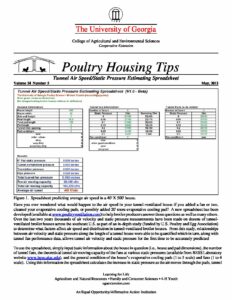Have you ever wondered what would happen to the air speed in your tunnel-ventilated house if you added a fan or two, cleaned your evaporative cooling pads, or possibly added 20' more evaporative cooling pad? A new spreadsheet has been developed (available at www.poultryventilation.com) to help broiler producers answer those questions as well as many others. Over the last two years thousands of air velocity and static pressure measurements have been made on dozens of tunnel-ventilated broiler h...ouses across the southeast U.S. as part of an in-depth study (funded by U.S. Poultry and Egg Association) to determine what factors affect air speed and distribution in tunnel-ventilated broiler houses. From this study, relationships between air velocity and static pressure along the length of a tunnel house were able to be quantified which in turn, along with tunnel fan performance data, allows tunnel air velocity and static pressure for the first time to be accurately predicted
To use the spreadsheet, simply input basic information about the house in question (i.e., house and pad dimensions), the number of tunnel fans, the theoretical tunnel air moving capacity of the fans at various static pressures (available from BESS Laboratory website www.bess.uiuc.edu), and the general condition of the house’s evaporative cooling pads (1 to 5 scale) and fans (1 to 4 scale). Using this information the spreadsheet calculates the increase in static pressure as the air moves through the pads, tunnel doors, into the cross-section of the house and along the length of the house to determine the total static pressure the tunnel fans are working against (Poultry Housing Tips - www.poultryventilation.com/sites/default/files/tips/2010/vol22n9.pdf). Once the total static pressure is calculated the air moving capacity of the tunnel fans is then estimated using the inputted fan performance information, taking into account their condition. The total air moving capacity of the tunnel fans is then divided by the cross-sectional area of the house to obtain an average tunnel air velocity.
In addition to estimating the average air speed and total static pressure, the spreadsheet shows how each area of the house (i.e, pad, tunnel doors/curtain opening, etc.) contributes to the total pressure the tunnel fans are working against. The spreadsheet also allows the addition of new fans to an “existing” house to aid in determining how many additional fans would be required to obtain, for instance, an average air speed of 600 ft/min and illustrating how increasing pad area is beneficial when adding fans.
The spreadsheet can be used to help answer a variety of questions about air speed and static pressure in a tunnel-ventilated house such as:
How does evaporative cooling pad condition affect air speed?
How does the condition of the tunnel fans affect air speed?
How does adding fans and not increasing pad area affect air speed?
How does tunnel door/curtain size affect air speed?
How does increasing pad area affect air speed?
For instance, a producer can get an estimation of what would happen to air speed and static pressure in a house if two new 54" fans were added to the existing eight tunnel fans. Furthermore, the spreadsheets could be used to predict what would happen to air speed and static pressure in the same house if the pad became very dirty after adding the two new fans.
The average air velocity predicted by the spreadsheet house is generally within +/- 5% of what has been actually measured in the field. That being said it is important to keep in mind the following:
1) Pad and fan condition are subjective measurements and as a result can make it difficult to predict an accurate average air speed.
2) The spreadsheet calculates “average” air velocity which can be very difficult to measure in the field.
3) Accurate fan test information can be difficult to obtain for many older tunnel fans.
4) The spreadsheet was developed based on data from dropped-ceiling broiler houses. As a result it will not accurately predict the average air speed and design static pressure in breeder, layer or houses with deflector curtains.
5) Fans with worn belts and dirty shutters generally should be given a rating of 4.
6) Fans over 5 years old should generally be given a condition rating of 2 or higher.
7) Pads over 5 years old should generally be given a condition rating of 3 or higher.
Airspeed is the primary method of cooling poultry in hot weather and many producers are interested in maximizing bird cooling. People often overestimate their airspeed because most measure it in the middle of the house. In many cases people add tunnel fans, but do not take into account the effect that the extra static pressure created will have on the older tunnel fans in the house. The purpose of this spreadsheet is to provide people with realistic estimate of their average house speed, and to help ensure that they are investing their money wisely by making house improvements that will result in overall improved bird cooling. Even if there are no plans to update houses in the future, producers will find it informative to run a variety of scenarios regarding fan and evaporative cooling pad condition the effect on airspeed.
Details
| Year | Volume | Number | Categories |
|---|---|---|---|
| 2012 | 24 | 5 |

